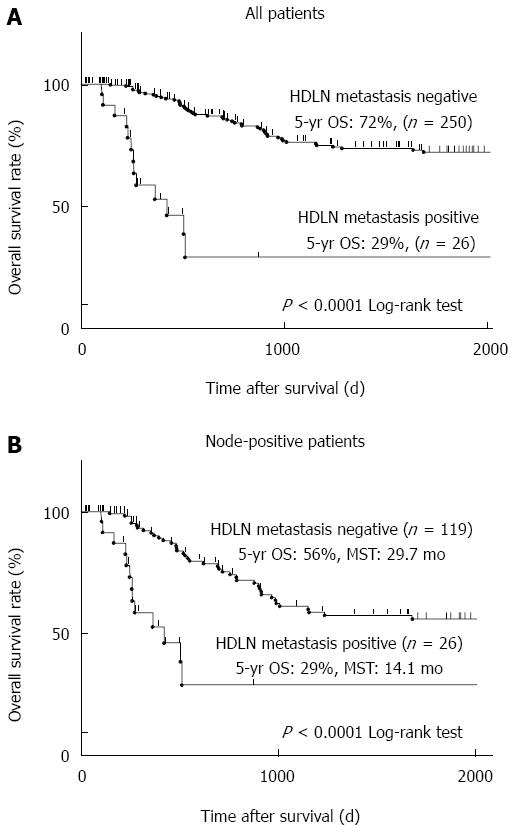Copyright
©The Author(s) 2015.
World J Gastroenterol. Oct 14, 2015; 21(38): 10866-10873
Published online Oct 14, 2015. doi: 10.3748/wjg.v21.i38.10866
Published online Oct 14, 2015. doi: 10.3748/wjg.v21.i38.10866
Figure 1 Five-year overall survival of gastric cancer patients based on hepatoduodenal lymph node metastasis.
A: All 276 patients analysed in this study were divided into two groups based on hepatoduodenal lymph node (HDLN) metastasis. A group with HDLN metastasis (n = 26) and that without HDLN metastasis (n = 250) were compared. Kaplan-Meier survival curves were statistically analysed by the log-rank test (P < 0.0001); B: The patients who had lymph node metastasis (n = 145) were divided into two groups and analysed as described in panel a (26 patients with HDLN metastasis and 119 patients without HDLN metastasis, P < 0.0001).
Figure 2 Five-year overall survival curves of gastric cancer patients based on the extent of lymph node metastasis.
A: Twenty-six patients who had hepatoduodenal lymph node (HDLN) metastasis were divided into two groups based on the extent of lymph node metastasis. A group of pathological (p)N1 or N2 (n = 10) and that of pN3 (n = 16) were compared as described in Figure 1 (P = 0.0024); B: All 82 pN1 or N2 patients were divided into two groups based on HDLN metastasis and analysed as described in Figure 1 (10 patients with HDLN metastasis and 72 patients without HDLN metastasis, P = 0.602); C: All 63 pN3 patients were analysed as described in Figure 1 (16 patients with HDLN metastasis and 47 patients without HDLN metastasis, P < 0.0001).
- Citation: Imamura T, Komatsu S, Ichikawa D, Kosuga T, Okamoto K, Konishi H, Shiozaki A, Fujiwara H, Otsuji E. Clinical characteristics of hepatoduodenal lymph node metastasis in gastric cancer. World J Gastroenterol 2015; 21(38): 10866-10873
- URL: https://www.wjgnet.com/1007-9327/full/v21/i38/10866.htm
- DOI: https://dx.doi.org/10.3748/wjg.v21.i38.10866










